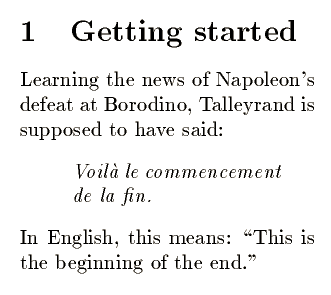| An example |
Without worrying about the details, you can get a general idea of what LaTeX markup looks like from the following short LaTeX source file:
\documentclass{article}
\setlength{\textwidth}{5cm}
% the above command makes a narrow
% page width for demonstration purposes
\pagestyle{empty}
\begin{document}
\section{Getting started}
Learning the news of
Napoleon's defeat at
Borodino, Talleyrand is
supposed to have said:
\begin{quote}
\emph{Voil\`a le commencement de la fin.}
\end{quote}
In English, this means:
``This is the beginning of the end.''
\end{document}
 The figure shows the printed output that LaTeX produces from this
source file.
Observe that the output looks much different from the input
source file. A backslash signifies a LaTeX formatting command;
the control sequences starting with backslashes do not
appear in the output. None of the font changes or line breaks is
declared explicitly in the source file.
The figure shows the printed output that LaTeX produces from this
source file.
Observe that the output looks much different from the input
source file. A backslash signifies a LaTeX formatting command;
the control sequences starting with backslashes do not
appear in the output. None of the font changes or line breaks is
declared explicitly in the source file.
 The Math 696 course
pages were last modified April 5, 2005.
The Math 696 course
pages were last modified April 5, 2005.| An example |